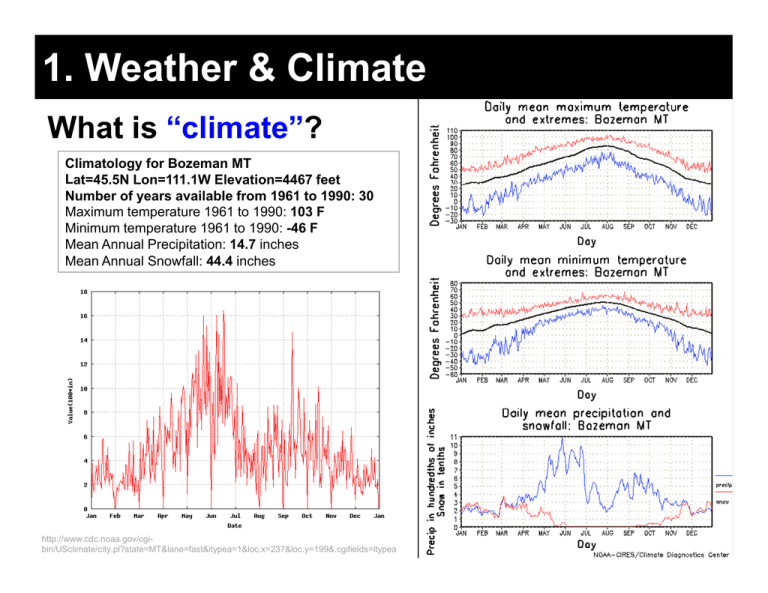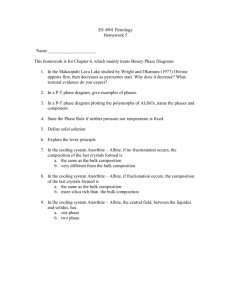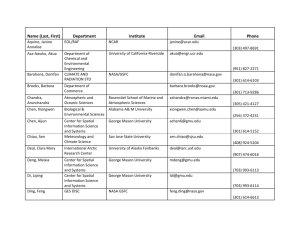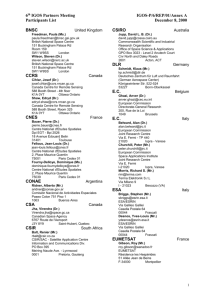1. Weather & Climate What is ? “climate”
advertisement

1. Weather & Climate What is “climate”? Climatology for Bozeman MT Lat=45.5N at 5 5 Lon=111.1W o Elevation=4467 e at o 6 feet eet Number of years available from 1961 to 1990: 30 Maximum temperature 1961 to 1990: 103 F Minimum temperature 1961 to 1990: -46 F Mean Annual Precipitation: 14.7 inches Mean Annual Snowfall: 44.4 44 4 inches 1 http://www.cdc.noaa.gov/cgibin/USclimate/city.pl?state=MT&lane=fast&itypea=1&loc.x=237&loc.y=199&.cgifields=itypea 3. Reading Weather Maps http://www.montana.edu/mcwethy/ERTH303/ 2 3. Reading Weather Maps 3 http://www.opc.ncep.noaa.gov 3. Reading Weather Maps – station data http://www.montana.edu/mcwethy/ERTH303/ 4 3. Reading Weather Maps – station data Weather: Sky Conditions: 5 3. Reading Weather Maps – station data Wind: Pressure Trend: 6 3. Reading Weather Maps 7 http://www.opc.ncep.noaa.gov/UA/USA.gif Weather and Climate News • Does it feel unusually cold? National Water and Climate Center temperature precipitation snow 8 Composition and Structure of the Atmosphere (ERTH 303, 3 September, 2009) 1. Composition a. b. c. The atmosphere Permanent gases Variable gases 2. Vertical Structure a. b. c. Temperature Electrical properties Function 9 1. Composition of the Atmosphere ≈ 100 km ≈ 12 km thunder heads Æ Where does Earth’s Earth s atmosphere end? 100 km Æ 99.99997% 2% of Earth’s thickness 10 Photo from NASA: http://eobadmin.gsfc.nasa.gov/Newsroom/NewImages/images.php3?img_id=17542 inp put rate Physical Processes: • chemical reactions • volcanic eruptions Biological Processes: • photosynthesis p y • respiration • human activity output rrate 1. Composition – components cycle 11 Photo from NASA: http://eobadmin.gsfc.nasa.gov/Newsroom/NewImages/images.php3?img_id=17542 1. Composition (and some structure) Permanent Gases (homosphere: 0-80 km alt.) 12 Aguado and Burt, Table 1-2. 1. Composition (and some structure) Variable Gases Methane CH4 0.00017 76.01 Low abundance, but very important 13 Aguado and Burt, Table 1-3, with Methane added. 1. Composition Water Vapor Gas molecules (not liquid), source for cloud formation Radiative forcing = ++ Created by evaporation Removed by precipitation Residence time = 10 days clouds water vapor 14 http://wwwghcc.msfc.nasa.gov/GOES/goeseastconuswv.html - 1 September, 2008 1. Composition Carbon Dioxide Radiative forcing = + Input: respiration, organic i d decay, volcanic l i eruptions, anthropogenic activity Uptake: photosynthesis Residence time = 150 yr From the Mauna Loa Observatory: http://www.mlo.noaa.gov/home.html 1. Composition Methane Radiative Forcing = + Input: wetlands, termites, anthropogenic th i activity ti it Uptake: soils, Atmosphere Residence time = 10 yr http://www.esrl.noaa.gov/gmd/ccgg/iadv/ 1. Composition Ozone Radiative Forcing g=+ (nearby), − (up high) Input: chemical reactions involving ultraviolet radiation Destroyed via chlorine containing chlorine-containing compounds chlorofluorocarbons http://www.epa.gov/air/oaqps/gooduphigh/ 18 1. Composition Ozone-depleting chemicals: 100 yr lifetime (effective equivalent chlorine - EECl) year NOAA Earth Systems Research Lab: http://www.esrl.noaa.gov/gmd/hats/graphs/graphs.html 1. Composition Ozone-depleting chemicals: 100 yr lifetime (effective equivalent chlorine - EECl) http://toms.gsfc.nasa.gov/multi/ozone_time_series.jpg What is a DU? – Dobson Units 1. Composition Ozone-hole http://toms.gsfc.nasa.gov/multi/ozone_time_series.jpg What is a DU? – Dobson Units 2. Vertical Structure – via function Ozonosphere: maximum ozone concentrations (20-30 km) 22 http://ozonewatch.gsfc.nasa.gov/index.html August 30th, 2009 Weather and Climate News 23 NYT Link: http://www.nytimes.com/2008/09/04/science/04cyclone.html?ref=science# Nature Link: http://www.nature.com/nature/journal/v455/n7209/pdf/nature07234.pdf 1. Composition Aerosols (aka particulates) Small ((0.1 μ μm radii), ), function as condensation nuclei Radiative forcing = − Input: sulfate conversion, dust, volcanoes, sea spray, combustion Removed by precip. Residence time = days to weeks k to months h (if in stratosphere) MT ID WY Fires in Idaho and Montana producing visible aerosols, August 7, 7 2000. 2000 Source: NASA Visible Earth project http://visibleearth.nasa.gov/view_rec.php?id=676 Composition and Structure of the Atmosphere 1. Composition a. b. Permanent gases Variable gases 2. Vertical Structure a. b. c. d. Density Temperature Electrical properties Function 25 2. Vertical Structure – via density den nsity (kg / m3) Density = mass per unit volume Aguado and Burt Fig. 1-8. Because air is compressible and subjected to greater compression at lower elevations, the density of the air at lower levels is greater than that aloft. Mean free p path = average distance traveled before colliding with another 26 molecule. e.g. 0.0001 mm at 0 km asl vs. 1 km at 250 km asl 2. Vertical Structure – via temp. Why temperature? Wh t t ? temperature impacts how easily air moves vertically (details revealed in Chapter 6) Standard Atmosphere = models defining atmospheric variables as a function of altitude, for a given set of mean conditions at sea level For example, the U.S. definition of “standard atmosphere” is described or defined in the following web sites: http://en.wikipedia.org/wiki/U.S._Standard_Atmosphere http://modelweb.gsfc.nasa.gov/atmos/us_standard.html 27 2. Vertical Structure – via temp. Thermosphere (“thermos” = heat) T increases with alt., to > 15,000°C little littl h heat, t b/ b/c low l d density it Mesosphere (“mesos” = middle) T decreases with alt. 99.9% of remaining atm. Stratosphere (“strato” = layer) T increases with alt., little vert. motion 19.9% of atm. ozone “layer” y between 20-30 km ((10 pp ppm)) Troposphere (“tropos” = turn) T decreases with alt. 80% of atm. by mass depth varies (8-16 km, mean 11 km) 28 2. Vertical Structure – via temp. ¾ Mesospause ¾ Stratopause ¾ Tropopause 29 2. Vertical Structure – via electrical properties Ionosphere: defined by electrical properties reflects fl t AM radio di waves responsible for aurora 30 http://en.wikipedia.org/wiki/Ionosphere QUIZ #1 Name Date Class (1) Why is the ozone layer important? It blocks harmful shortwave radiation yet allows long-wave long wave radiation to reach the earth’s surface which supports biological processes (photosynthesis) (2) What is the difference between water vapor and visible clouds? W Water vapor is i a gas and d visible i ibl clouds l d are made d up off liliquid id molecules l l (condensed water vapor. 31 QUIZ #1: Answers (3a) 1. (Right plot) what is the atmospheric pressure associated with the High in MT? 1023 2. Where is there a low pressure trough? NE MT or S. Idaho (3b) (Left plot) what is the wind direction and approx. speed? 5 knots 1. (left plot) what is the atmospheric pressure? 1018.5 2. (left plot) what is the atmospheric pressure trend? Decreasing then stable 3 (left plot) what is the sky cover? clear 3. 32 Weather and Climate News Global temperature anomalies: 1881-2008 2008 was coolest l t yr. since i 2000 but b t ninth i th warmestt since i 1881 (2005 1st, 2007, 2nd) http://svs.gsfc.nasa.gov 33



